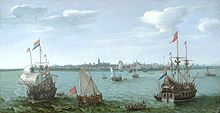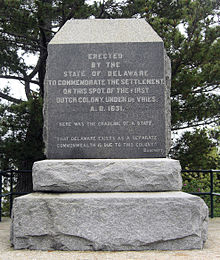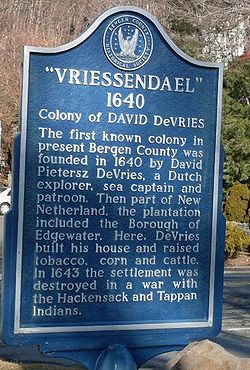- David Pietersz. de Vries
-
New Netherland series Exploration Fortifications: • Fort Nassau (North)
• Fort Orange
• Fort Nassau (South)
• Fort Goede Hoop
• De Wal
• Fort Wilhelmus
• Fort Beversreede
• Fort Nya Korsholm
• De Rondout
Settlements: • Rensselaerswyck
• Beverwijck
• Wiltwyck
• Bergen
• Pavonia
• Vriessendael
• Achter Col
• Heemstede
• Rustdorp
• Midwout
• Boswyck
• Swaanendael
The Patroon System Directors of New Netherland: Cornelius Jacobsen May (1620-25)
Willem Verhulst (1625-26)
Peter Minuit (1626-32)
Sebastiaen Jansen Krol (1632-33)
Wouter van Twiller (1633-38)
Willem Kieft (1638-47)
Peter Stuyvesant (1647-64)
People of New Netherland Flushing Remonstrance Captain David Pieterszoon de Vries (c. 1593, La Rochelle - probably 1662, Hoorn[1]) was a Dutch navigator from Hoorn, Holland.
In 1617 de Vries went on a whaling voyage to Jan Mayen. In 1620 he sailed to Newfoundland and sold the dried fish in Italy. In Toulon he joined Charles, Duke of Guise. In 1624 he went to Canada again, still in French service. After returning in the Netherlands, the Dutch West India Company put an embargo on his ship. De Vries sold his ship and left for Bayonne.
In 1627 he sailed from Hoorn to Batavia. On board was Jan Pietersz Coen only recognized during the trip. From the Dutch Indies he sailed to Masulipatnam.
In 1629, 28 colonists sailed to North America and planted the Zwaanendael Colony in Lewes, Delaware, for patroons of the company organized by five merchants from New Amsterdam: Kiliaen de Rensselaer, Samuel Godijn, Samuel Blommaert, Albert Burgh, Joannes de Laet and De Vries. In the next year it became clear the colony Zwaanendael was destroyed. Upon his visit in 1632, de Vries found the settlers massacred and their fort burned to the ground. [2]
He returned on trading trips to North America twice, eventually establishing patroonships on Staten Island (1639) and at Tappan, known as Vriessendael (1640)[3]
De Vries often acted as a go-between trying to keep the peace between the Lenape and New Netherlands director-general William Kieft. De Vries famously tried to prevent Kieft from launching the Pavonia Massacre, which set off Kieft's War. After the massacre, De Vries was influential in bringing the Hackensack Indians sachem Oratam to negotiate a truce, which did not hold in the face of Kieft's aggressive policies.[4] De Vries became a leading figure in the popular uprising against Kieft in the Dutch colony which ultimately led to the director-general's dismissal and recall for trial. Disenchanted by the New Netherlanders treatment of the indigenous population, he left his farm at Vriessendael in October 1643, and returned to Holland.[1]
In 1655 he published "Korte Historiael Ende Journaels Aenteyckeninge" (Short Historical Notes and Journal Notes of Various Voyages).[1]
On top of the The Zwaanendael Museum in Lewes, Delaware, designed after the City Hall of Hoorn, stands a statue of De Vries. [5]
See also
External links
- Portrait of De Vries [1]
- (English)http://gdz.sub.uni-goettingen.de/dms/load/img/
- (English) http://www.jstor.org/pss/1919690
- http://www.antenna.nl/wvi/nl/nest/deVries.html
References
- ^ a b c Joris van der Meer Koopman in de West; De indianen en de Nieuw Nederlanders in het journaal van David Pietersz. De Vries, 2001 (Dutch)
- ^ "Voyages of De Vries." New York Historical Society Collection (new series), vol. iii. page 23.
- ^ Documents Relative to the Colonial History of the State of New-York, by John Romeyn Brodhead, et al., published 1881
- ^ Ruttenber,E.M.,Indian Tribes of Hudson's River, ISBN 0-910746-98-2 (Hope Farm Press, 3rd ed, 2001)
- ^ http://history.delaware.gov/museums/zm/zm_main.shtml
Categories:- 1590s births
- Dutch explorers
- Delaware colonial people
- People from Hoorn
- 1660s deaths
- People of New Netherland
Wikimedia Foundation. 2010.




